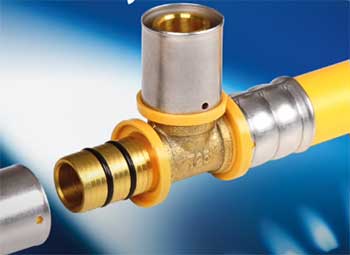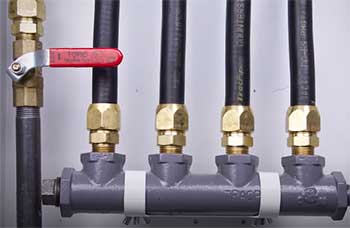The GasTite and the TracPipe fittings use different methods to seal the connection. GasTite fittings seal with a compression ring that is tightened by a nut on the inside of the fitting but can still be loosened with a wrench after tightening.
These are typically considered more secure than TracPipe, which requires specialized tools for removal. TracPipe fittings seal with a gasket that is pressed against the threads of the fitting. This closes the pipe connection completely.
A Quick Comparison Table
| Specifications | GasTite | TracPipe |
| Material | PPE cross-linked polyethylene | Stainless steel |
| Burst pressure | 300psi | 120psi |
| Heat resistance | Slightly affected by heat. | Resistant to the heat effect |
| Corrosion resistance | Slightly resistant | Highly resistant |
| Installation | Hard to install | Easy to install |
| Compatible material | PVC | PVC and stainless steel |
| Durability | They last between 15-60 years | They last up to 40 years |
Key Differences between GasTite And TracPipe Fittings
- Material

GasTite fittings are made from steel, brass, and aluminum.
Forged brass fittings were produced quickly but are no longer manufactured.
They are available in a variety of finishes, including both polished chrome and matte chrome finishes.
A new line of black anodized fittings has expanded its product offering.
Contemporary finishes include satin chrome, polished brass, and satin brass, with unique order options including a matte black oxide or polished antiqued bronze.
TracPipe fittings are usually made of stainless steel material or high-quality PVC. The quality of the material used to make the fittings makes them last longer than other types.
- Burst pressure
GasTite has a three times higher rating for burst pressure (300 psi vs. 120 psi), ensuring a higher flow rate if needed. Also, the system maintains fluid pressure as it stops, unlike the TracPipe, where pressure keeps increasing.
This is done by using an internal floating piston which moves and adapts to changes in fluid pressure. This is more effective than a simple sliding piston which wears out quickly because it is under constant pressure.
- Corrosion Resistance
GasTite offers better chemical compatibility with hydrocarbons like natural gas. So, you don’t have to worry about harmful gases sticking to your pipe while reducing the risk of corrosion.
This is accomplished by the high-quality, PPE cross-linked polyethylene used in the manufacturing of GasTite systems.
Since TracPipe is made using stainless steel, it is highly resistant to corrosion: water, heat, and chemical resistance.
- Compatible Material
TracPipe is the better choice if you are working with PVC pipes. The advantage of TracPipe over GasTite fittings is that it works well with both plastic and copper pipe, so you can pick a size that doesn’t look too large or too small for your lines.

TracPipe fittings are also easier to use, especially if you install a plumbing system in your home.
You don’t have to worry about getting the connection right and then having it leak.
If working with stainless steel is what you’re looking for, then look no further because TracPipe fittings are compatible with stainless steel pipes.
In addition, TracPipe fittings were explicitly created for the environment of outdoor plumbing systems and come with a lifetime warranty.
Since GasTite fittings are PPE cross-linked polyethylene, they can be used in plumbing projects featuring several materials. If you do a project using stainless steel, you will have to heat the material before installation.
- Durability
The most significant difference between GasTite and TracPipe fittings is the warranty they both provide. Because they are made of different materials, the life expectancy of each one varies.
Some GasTite fittings can last up to 60 years, while others can only last for 15 years. TracPipe fittings, on the other hand, can last up to 40 years, more than GasTite. They both have a lifetime warranty, but because of the different materials, they vary in cost and installation difficulty.
- Ease Of Installation
GasTite, heavy metal construction also adds to its weight, making it a challenge to install. However, this increases the installation cost because the fitting must be burned in before it becomes a permanent fixture.
Also, because it is installed into a permanent hole, making the hole larger can complete the installation difficult, if possible.
TracPipe, on the other hand, is lighter than GasTite and more easily installed. Plastic also makes it more durable than GasTite but less so than TracPipe fittings which come in brass or stainless steel.
Its installation process is relatively simple and does not require burning.
Frequently Asked Questions (FAQ)
The IAPMO sets standards for CSST fittings and the materials that can be used to create these fittings. These standards include the types of connections that can be used with CSST, the maximum pressure rating for these connections, and the maximum diameter of pipe CSST can safely be joined to. The standard states two acceptable methods of creating CSST: crimping and fusion.
The manufacturer says it lasts “virtually forever” with no need for repair or replacement because the pipe is made of durable polypropylene that never corrodes in contact with soil. Generally, you will get a 40 years warranty from the manufacturer.
Yes. You will find TracPipe fittings made of stainless steel. TracPipe fittings made of stainless steel have excellent corrosion resistance, but it is moderately easy to weld and can be used in either hot or cold service.
TracPipe does not need to be sleeved. It’s durable enough without any extra protection. The product is manufactured to ASTM F 2040 and can be installed in the grade, at grade, or on the ground.
Conclusion
The comparison of GasTite and TracPipe fittings is a topic that has not been settled for a long time. However, my post above has all the information you might need when deciding which fittings to use for your plumbing project.
GasTite is quite durable, slightly resistant to corrosion, but hard to use during installation. TracPipe, on the other hand, is highly resistant to corrosion, easy to install, and exceptionally durable.
Still, it has a lower burst pressure than GasTite, which has three times higher.
